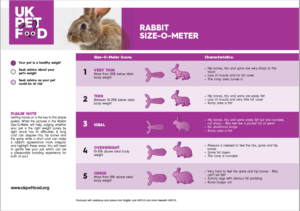We’ve heard about our dogs and cats getting heavier, but it might shock you to know that 30% of rabbits in the UK are also overweight. And like our other family pets, being overweight can cause some severe problems for our rabbits including:
• Cessation of caecotrophy (eating their poop). Although you may not know they do this, rabbits produce two types of faeces. One type is produced at night (usually) and are called caecotrophs. Caecotrophs are smelly, green-brown clusters of sticky droppings that the rabbit eats (yes eats!) straight from their anus. They must eat these as they are full of essential vitamins and minerals. Overweight rabbits struggle to reach their bottom to perform caecotrophy and this can result in nutrient imbalances. It also leads to the next problem of flystrike.
• Flystrike is a horrible condition which is often fatal for the rabbit. When the rabbit produces too many or cannot eat their caecotrophs they can get stuck to the fur around their bottom (known as ‘sticky bottom’). This attracts flies which lay their eggs in the soiled fur. Within a matter of hours, the eggs hatch and the maggots start to eat the rabbit’s flesh.
• Pododermatitis or sore hocks (feet) occur when the rabbit is hopping around on the wrong flooring and if the rabbit is overweight. It results in raw sores on the base of their hind feet, which are extremely painful and difficult to treat.
• Arthritis. Rabbits can suffer with osteoarthritis too and being overweight makes this much more likely. In fact, vets and vet nurses say that 42% of overweight rabbits that they see also have mobility problems.
Other conditions linked to obesity in rabbits include gastrointestinal stasis, urinary problems, an anaesthetic risk and a risk of fatty liver disease (hepatic lipidosis), which can occur if they lose weight too quickly – usually when an obese rabbit becomes ill.
How can you tell if your rabbit is overweight?
When you see your pet daily and the weight creeps on slowly, it can be difficult to see that they might be heavier than they should be. In the PDSA Paw report 2018, 26% of rabbit owners who said their bunny was the perfect weight picked out a photo of an overweight rabbit when they were asked to select the image most closely resembling their pets body shape.
So, we know it can be difficult to know if your rabbit is the correct weight. However, there are tools that can help. In the first instance we would recommend using a ‘body condition score’ chart, like this one from UK Pet Food:

The pictures can be useful, but if you run your hands over your rabbit, you should be able to use the characteristics information to help you score your rabbit’s weight from 1-5. If you’re still not sure, please ask when you come to the Klinic.
Other signs that your rabbit is too heavy include urine staining from sitting in one position too long, an unkempt coat because they are too fat to be able to groom themselves properly and sore feet, or a ‘sticky bottom’ as mentioned earlier.
Regular weighing each time your rabbit has a check-up is also a good way to monitor their weight. You can also weigh them at home in between visits to check.
What causes rabbits to become overweight?
The wrong diet and lack of exercise are the causes of weight gain in rabbits.
Rabbits need a diet high in fibre and to get this, they should be eating their body size in hay every day. Hay and grass should make up 85% of their diet, with 10% greens and only 5% rabbit food. Rabbit pellets are recommended over muesli , but pellets are still lower in fibre and higher in calories than hay and this will contribute to weight gain if they are eating too much.
Fruit and carrots should only ever be given to rabbits as a very occasional treat and not at all for overweight rabbits. Although, these are natural they are high in sugars. We advise swapping them for some tasty herbs instead like fresh or dried parsley or mint. Treats like seeded snacks or yoghurt drops are also not suitable and should be avoided.
Some of the hutches for sale in shops today are smaller than the legal requirements for laboratory cages for rabbits, so take care to ensure there is plenty of space before you buy accommodation. The minimum sized hutch for rabbits is 6 x 2 x 2 feet and it should have a predator safe run attached for exercise at all times, in total they should have permanent access to a space of at least 3 metres by 2 metres. Alternatives to hutches include converted garden sheds (which can work out less costly) or indoor rabbit pens. Without access to space to hop and move about rabbits will become bored and gain weight.
What else can you do?
If you’ve established that your rabbit could do with losing a little weight, it is important to do this gradually. Start by encouraging exercise by scattering food for them to find, or hiding it in puzzle feeders or cardboard toilet tubes. Gradually wean out any fruit or commercial treats and increase the hay you are offering. Try offering different types of hay to encourage them to eat the food. Access to a run on grass is the best way to ensure they are exercising and eating the right diet.
For more information on rabbit health and behaviour go to the Rabbit Welfare Association and Fund (RWAF)

